Kabul is the capital of Afghanistan and is also home to various birds. From soaring hawks to colorful songbirds, this city is filled with the sights and sounds of nature. Kabul is a great place to observe birds in their natural habitat.
Birdwatchers can find a variety of species, including house sparrows, Eurasian collared doves, and black kites. Kabul is also great for spotting migratory birds worldwide, including white storks, hoopoes, and golden orioles.
Birdwatching is a great way to spend time in Kabul, and birding enthusiasts can find plenty of opportunities to observe and appreciate the beauty of birds in this city.
24 Birds to Watch in Kabul
Kabul, the capital of Afghanistan, is a city rich in history and culture. But it is also a city that has suffered from decades of war, violence and instability. Despite the challenges, Kabul is home to a diverse and resilient community of people who love their city and their country.
There are many birdwatchers who appreciate the beauty and diversity of the avian life that thrives in and around Kabul.
Here are 24 birds that you can watch in Kabul.
1. Egyptian Vulture
The Egyptian vulture is a small, Old World vulture belonging to the genus Neophron and is most commonly referred to as the white scavenger vulture or pharaoh’s chicken.
This species is widely distributed, with a range that stretches from the Iberian Peninsula and North Africa to India.
It is a critically endangered species, with its population decreasing due to a variety of factors, including habitat destruction, intentional poisoning, and electrocution.
The Egyptian vulture is a medium-sized vulture, with adults growing up to a length of 65 cm and a wingspan of 1.5 to 1.7 m. Its plumage is primarily white, with a yellowish-orange head and neck and a black patch on the back of the head.
Its bill is also yellow and has pale yellow eyes, giving it its characteristic appearance. The Egyptian vulture feeds mainly on carrion but will also take eggs, nestlings, and small mammals.
It is an opportunistic feeder and will take advantage of any food source it finds. It is also a social bird, often roosting and nesting in groups.
The Egyptian vulture is an essential species in its ecosystem, as it helps to keep the environment clean by scavenging on carcasses and prey.
It also provides a valuable food source for other species, such as the African fish eagle, which preys on the vulture’s eggs and young. Unfortunately, the species is in decline due to various human activities, including habitat destruction, poisoning, and electrocution.
For these reasons, it is essential to protect this species and its habitat to ensure its survival.
| Kingdom | Animalia |
| Phylum | Chordata |
| Class | Aves |
| Order | Accipitriformes |
| Family | Accipitridae |
| Genus | Neophron |
| Species | N. percnopterus |
2. Bar-headed Goose
The bar-headed goose is a species of goose that is native to Central Asia. This species of goose breeds in colonies of thousands near mountain lakes and is known to migrate across the Himalayas. It can be found as far south as peninsular India during the winter months.
When breeding, the bar-headed goose will lay three to eight eggs in a ground nest. This goose species is renowned for its ability to fly at extreme altitudes, making it one of the most remarkable migratory birds.
To survive the dangerous journey across the Himalayas, the bar-headed goose must fly at altitudes reaching up to 9,000 meters, allowing it to traverse the entire mountain range. This ability to survive in such extreme conditions makes the bar-headed goose unique.
| Kingdom | Animalia |
| Phylum | Chordata |
| Class | Aves |
| Order | Anseriformes |
| Family | Anatidae |
| Genus | Anser |
| Species | A. indicus |
3. Cinereous Vulture
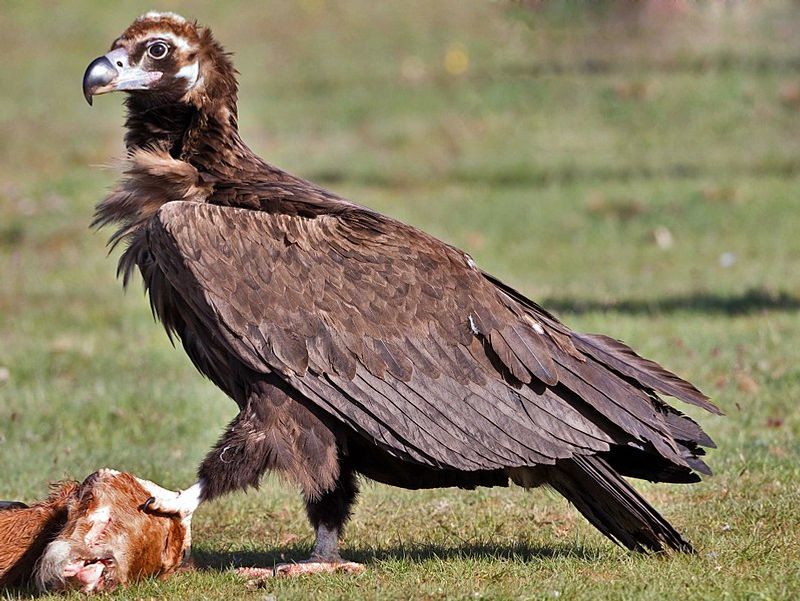
The cinereous vulture is a large bird of prey from the Accipitridae family. It is found in a wide range of temperate areas across Eurasia and is also commonly referred to as the black vulture, monk vulture, or Eurasian black vulture.
It has a wingspan of up to 2.5 meters and a body length of up to 1 meter, making it one of the more prominent members of the Accipitridae family. Its plumage is predominantly black, with white patches on the underside of its wings and tail.
Its head is bald, and its vast beak is well adapted for tearing flesh. The cinereous vulture feeds mainly on carrion, which it finds by soaring high in the sky in search of dead animals. It is also known to hunt small mammals and birds.
It is a social bird, often seen in flocks of hundreds of individuals, and it forms strong bonds with its mates.
The cinereous vulture is an essential species in the ecosystem, as it helps to keep the environment clean and healthy by consuming dead animals and reducing the risk of disease.
It is listed as near threatened on the IUCN Red List, as its population has been declining due to habitat loss, illegal hunting, and accidental poisoning from eating animal carcasses.
Conservation efforts are needed to protect this species and ensure it continues playing an essential role in its ecosystem.
| Kingdom | Animalia |
| Phylum | Chordata |
| Class | Aves |
| Order | Accipitriformes |
| Family | Accipitridae |
| Genus | Aegypius |
| Species | A. monachus |
4. Common Merganser
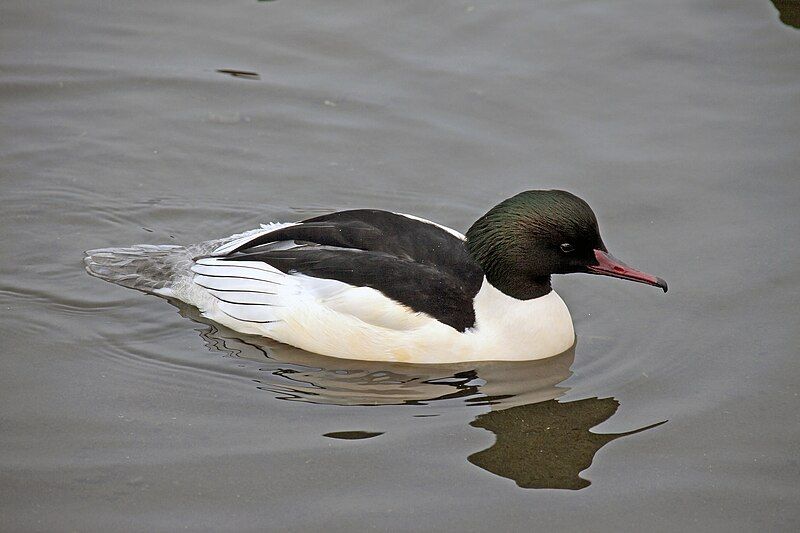
The common merganser, or the goosander, is a large seaduck found in rivers, lakes, and other aquatic habitats in Europe, Asia, and North America. It is easily recognizable due to its large size and glossy black or greenish-black head.
The common merganser mainly feeds on fish, making it one of the few seaducks that are primarily piscivorous.
It also consumes insects, mollusks, crustaceans, amphibians, and small mammals. The common merganser typically nests in cavities created by other birds, such as woodpeckers or kingfishers, in trees near water. The female lays anywhere from 7 to 15 eggs in a clutch.
Both parents take turns incubating the eggs while the male stands guard.
After the chicks hatch, the female will lead them to the water, where they can learn to forage and swim. The common merganser is an essential species for the ecosystems it inhabits. It serves as a predator of fish and other aquatic species and a prey species for raptors and other predators.
It is also an essential indicator of the health of aquatic ecosystems, as its presence can signify that the habitat is suitable for a wide variety of marine life.
| Kingdom | Animalia |
| Phylum | Chordata |
| Class | Aves |
| Order | Anseriformes |
| Family | Anatidae |
| Genus | Mergus |
| Species | M. merganser |
5. Common Shelduck
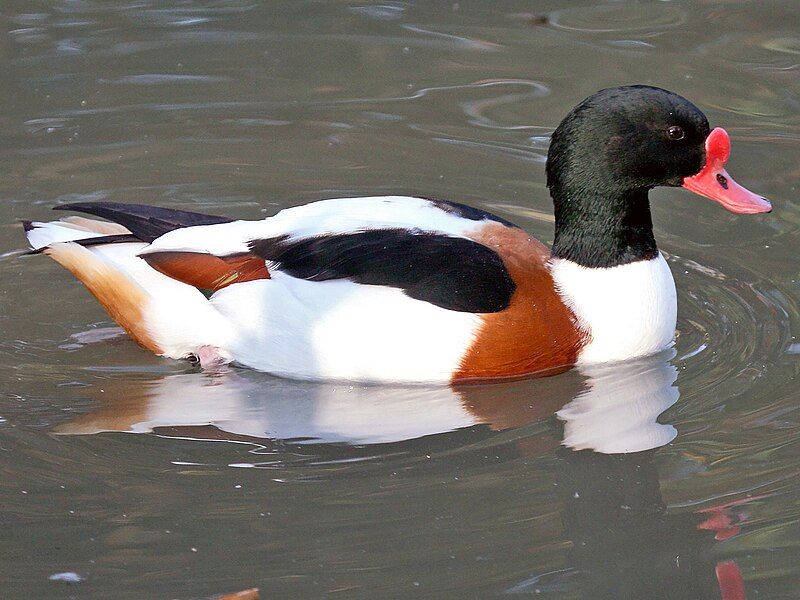
The common shelduck is a species of waterfowl that is part of the shelduck genus Tadorna. It is a widespread species found in the Euro-Siberian region of the Palearctic region. This species mainly breeds in temperate areas and winters in subtropical regions.
During the winter months, the common shelduck can also be found in the Maghreb, a region in North Africa. This species is considered relatively common in the areas where it is found. Its habitat consists of wetlands, estuaries, and shallow coastal areas.
The common shelduck is a medium-sized bird with a wingspan of up to 90 centimeters. It has a brownish-grey body and a white head and neck. Its diet consists of aquatic plants, insects, small fish, frogs, and mollusks.
| Kingdom | Animalia |
| Phylum | Chordata |
| Class | Aves |
| Order | Anseriformes |
| Family | Anatidae |
| Genus | Tadorna |
| Species | T. tadorna |
6. Cotton Pygmy Goose
The Cotton Pygmy Goose, also known as the Cotton Teal, is a small bird found in many parts of Asia, from Southeast Asia to Queensland.
This species of duck is a perching duck, meaning they usually live in trees or on other high structures rather than simply living in the water like some other duck species. The Cotton Pygmy Goose is exciting due to its wide range of habitats.
They can be found in wetland areas, ponds, lakes, rice paddies, and other agricultural regions.
In Queensland, they are sometimes referred to as White-quilled Pygmy Geese. The Cotton Pygmy Goose is a small duck species with a length ranging from 19 to 22 cm and a wingspan of up to 48 cm.
They have a relatively small bill, up to 2.5 cm long, and a bright white throat and breast. Their wings are mainly grey, with black and white feathers at the tips.
Their underparts are white, and their upperparts are a pale grey. The Cotton Pygmy Goose is an omnivore whose diet consists of small insects, aquatic invertebrates, and plant material. They are usually found in small groups, and they have a variety of different calls.
They are a monogamous species, and they are known to breed during the wet season.
The female usually lays around 6-8 eggs at a time. The Cotton Pygmy Goose is a small, perching duck found throughout Asia and even in Queensland, where it is sometimes called the White-quilled Pygmy Goose.
They are omnivores, and they are usually found in small groups. The female usually lays 6-8 eggs at a time, and they are a monogamous species.
| Kingdom | Animalia |
| Phylum | Chordata |
| Class | Aves |
| Order | Anseriformes |
| Family | Anatidae |
| Genus | Nettapus |
| Species | N. coromandelianus |
7. White-headed Duck
The white-headed duck is a small diving duck that measures about 45 cm in length. It is easily recognizable due to its distinct features. The male has a white head with a black crown, a blue bill, and reddish-grey plumage. The female has a dark bill and duller coloring.
This duck breeds in lakes with open water and dense vegetation at the edges. The vegetation provides shelter and protection from predators, allowing the duck to safely nest and raise its young.
The dense vegetation also provides ample food for the duck, such as water invertebrates and small fish, which it can easily catch and feed on.
The white-headed duck is an essential species as it is a species of conservation concern, and its population has decreased in recent years.
| Kingdom | Animalia |
| Phylum | Chordata |
| Class | Aves |
| Order | Anseriformes |
| Family | Anatidae |
| Genus | Oxyura |
| Species | O. leucocephala |
8. Velvet Scoter
The Velvet Scoter, or Velvet Duck, is a large sea duck breeds in the far north of Europe and the Palearctic region west of the Yenisey basin. The name of the genus Melanitta is derived from Ancient Greek, with “melas” meaning “black” and “Netta” meaning “duck.”
The species name, fuscus, is from the Latin word “dusky brown.” This duck species is typically dark brown, with males having a white patch on their wings.
The Velvet Scoter is a large duck, measuring up to 32 inches long, with a wingspan of up to 46 inches. They feed on mollusks, crustaceans, insects, and small fish, which they dive for in shallow water.
They spend winter in coastal waters and migrate to breed in the summer months.
| Kingdom | Animalia |
| Phylum | Chordata |
| Class | Aves |
| Order | Anseriformes |
| Family | Anatidae |
| Genus | Melanitta |
| Species | M. fusca |
9. Golden Eagle
The golden eagle is a majestic bird of prey found throughout the Northern Hemisphere. It belongs to the family Accipitridae, which makes it an actual eagle.
It is one of the most revered and recognizable birds of prey worldwide, and its wide distribution makes them a common sight in many regions. The golden eagle is a mighty hunter that feeds on small mammals, such as rabbits, rodents, and other birds.
Its razor-sharp talons and keen eyesight make it an efficient predator. The golden eagle is also a powerful symbol in many cultures, with its regal demeanor and large size making it the perfect symbol of strength and power.
It is a cherished species that deserves our respect and protection.
| Kingdom | Animalia |
| Phylum | Chordata |
| Class | Aves |
| Order | Accipitriformes |
| Family | Accipitridae |
| Genus | Aquila |
| Species | A. chrysaetos |
10. Demoiselle Crane
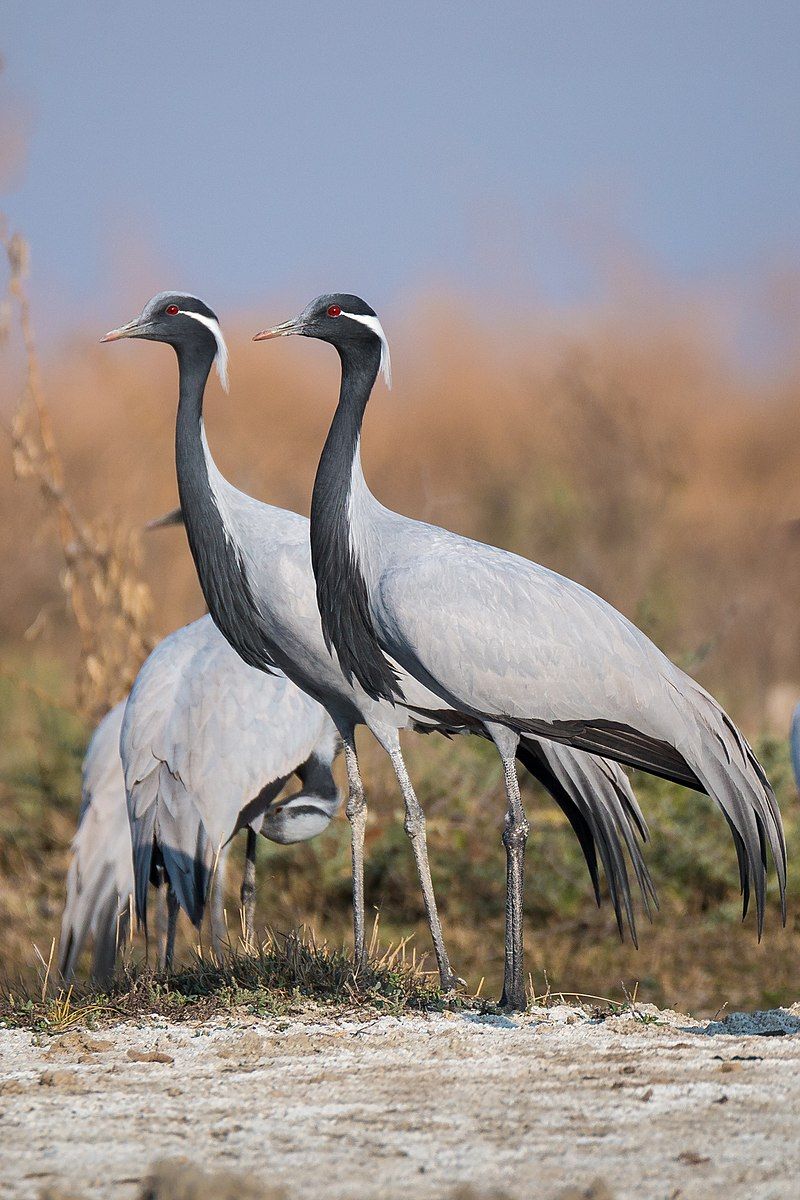
The demoiselle crane is a species found in many countries in central Eurosiberia, ranging from the Black Sea to Mongolia and Northeast China. It is a migratory bird, flying from its breeding grounds in the summer to its wintering grounds in the winter.
The demoiselle crane is a beautiful species with a silver-gray body, a black crown, and a black stripe along its neck. Its wings are white and tipped with black. It has a long neck and long legs that are also black.
These cranes feed primarily on insects, small birds, and small mammals. There is also a small breeding population of demoiselle cranes in Turkey. These cranes are migratory birds flying from their summer breeding grounds to wintering grounds in the winter.
Migratory birds like the demoiselle crane are essential for many reasons, including helping to maintain healthy ecosystems, providing a wide range of habitats for other species, and providing critical food sources for predators and scavengers.
The demoiselle crane is an essential species in central Eurosiberia, as it helps keep the natural balance in the region.
It is also an important species for people, as it provides a food source, and its beauty makes it a popular species to watch. The demoiselle crane is a species worth protecting, as it benefits the environment and people.
| Kingdom | Animalia |
| Phylum | Chordata |
| Class | Aves |
| Order | Gruiformes |
| Family | Gruidae |
| Genus | Grus |
| Species | G. virgo |
11. Greater Flamingo
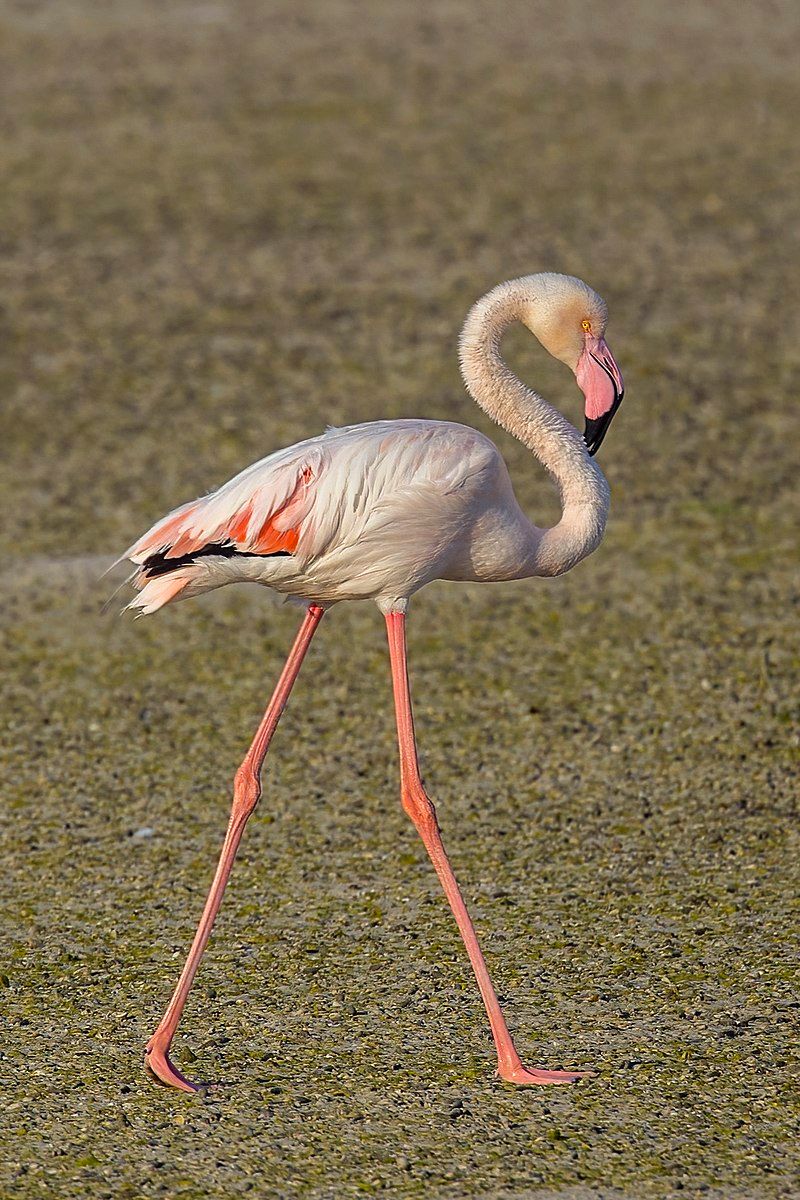
The greater flamingo is one of the most recognizable members of the family and is the most significant and widespread species.
Native to the Old World, these flamingos can be found throughout Northern and Sub-Saharan Africa, the Indian Subcontinent, the Middle East, the Levant, the Persian Gulf, the Gulf of Aden, the Red Sea, and the Mediterranean countries of Southern Europe.
The flamingo is an iconic bird, and its bright pink feathers can be seen in many places throughout its range. Its diet consists mainly of crustaceans and other invertebrates, which it filters from the water using its long, curved bill.
Greater flamingos are highly social birds, often seen in large flocks in wetlands, mudflats, and lagoons. They are also known to breed in colonies; in some areas, their colonies can cover up to 200 acres.
As a result of their extensive range and population, the greater flamingo is considered to be of least concern by the International Union for Conservation of Nature.
| Kingdom | Animalia |
| Phylum | Chordata |
| Class | Aves |
| Order | Phoenicopteriformes |
| Family | Phoenicopteridae |
| Genus | Phoenicopterus |
| Species | P. roseus |
12. Common Goldeneye
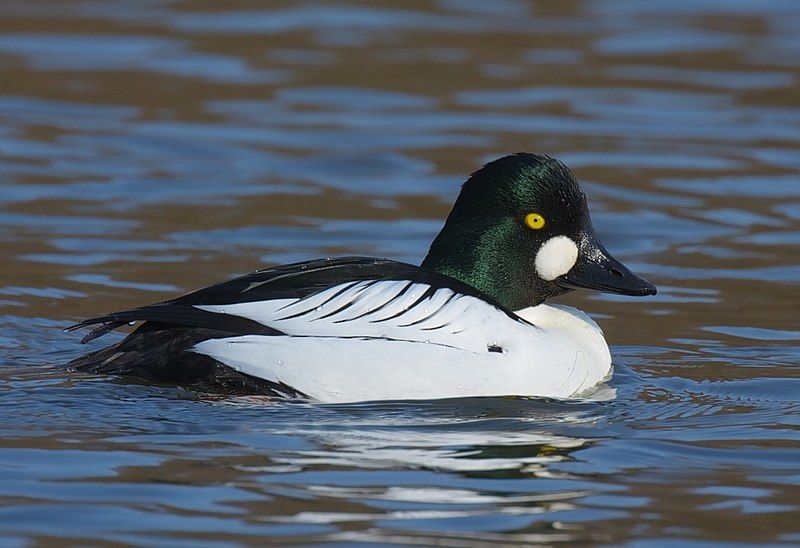
The common goldeneye is a type of sea duck that belongs to the genus Bucephala. It is closely related to the Barrow’s goldeneye, another sea duck species.
The genus Bucephala comes from Ancient Greek, with “boukephalos” meaning “bulbous head” – a reference to the bufflehead, another sea duck species. The common goldeneye is a medium-sized sea duck with a distinctive head shape that is easily identifiable.
It has a black upper body and a white lower body, with a yellow eye that gives it its name. The common goldeneye typically prefers freshwater habitats, such as rivers, lakes, and wetlands, but is also known to inhabit estuaries and coastal waters.
It feeds mainly on aquatic invertebrates and takes small fish and crustaceans. The common goldeneye is an essential species for waterfowl hunters and a famous game bird.
| Kingdom | Animalia |
| Phylum | Chordata |
| Class | Aves |
| Order | Anseriformes |
| Family | Anatidae |
| Genus | Bucephala |
| Species | B. clangula |
13. Common Pochard
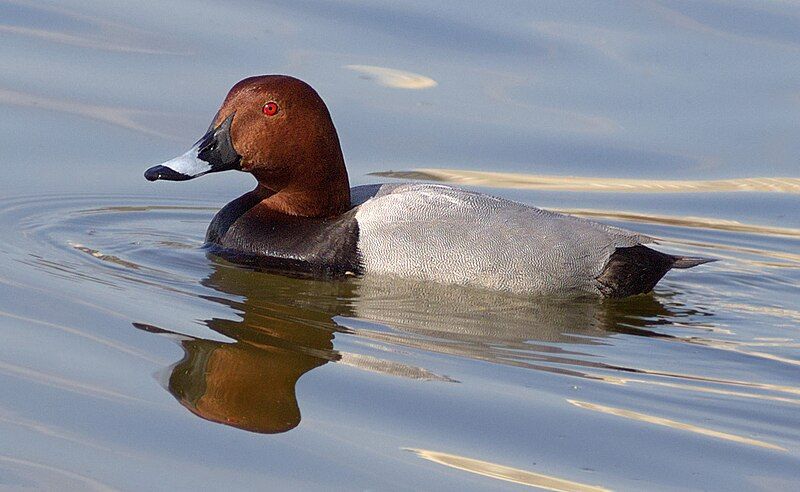
The common pochard is a species of duck typically found in bodies of water. Its scientific name, Aythya ferina, is derived from two sources.
The first source is the Greek word Lithuania, a reference to an unidentified seabird mentioned by various authors, including Hesychius and Aristotle.
The second source is the Latin word ferina, which refers to “wild game” or a feral animal living in its natural environment. For us, the root of the word ferina means “wild.”
This scientific name reflects the wild nature of the common pochard, a species of duck that lives in its natural habitat.
| Kingdom | Animalia |
| Phylum | Chordata |
| Class | Aves |
| Order | Anseriformes |
| Family | Anatidae |
| Genus | Aythya |
| Species | A. ferina |
14. Eurasian Wigeon
The Eurasian wigeon is a species of dabbling duck native to the Palearctic region. It is also known as the European wigeon, the widgeon, or simply the wigeon. This species is one of three species of wigeon in the genus Mareca.
It is a widespread bird found in most parts of its range. The Eurasian wigeon is a medium-sized duck with a bright chestnut head and neck, grey-speckled back, and wings. The male has a white crown, a green eye patch, and a bright orange bill.
The female, on the other hand, is primarily brown with a white-speckled belly. Both sexes have a distinctive white patch on the flank. The Eurasian wigeon is a highly social species that often feeds in large flocks.
It eats mainly aquatic vegetation, such as algae and submerged plants, insects, and other small animals. It is also known to eat grain on agricultural land and in parks. Eurasian wigeons typically breed in the spring and summer.
The female builds a nest on the ground near water, usually close to tall vegetation. The female incubates the eggs, while the male defends the nest and the female.
After the chicks hatch, they are cared for by both parents. The Eurasian wigeon is an essential species for waterfowl hunters, especially during winter. It is also widely hunted for its meat and eggs.
The species is classified as Least Concern by the International Union for Conservation of Nature (IUCN).
| Kingdom | Animalia |
| Phylum | Chordata |
| Class | Aves |
| Order | Anseriformes |
| Family | Anatidae |
| Genus | Mareca |
| Species | M. penelope |
15. Ferruginous Duck
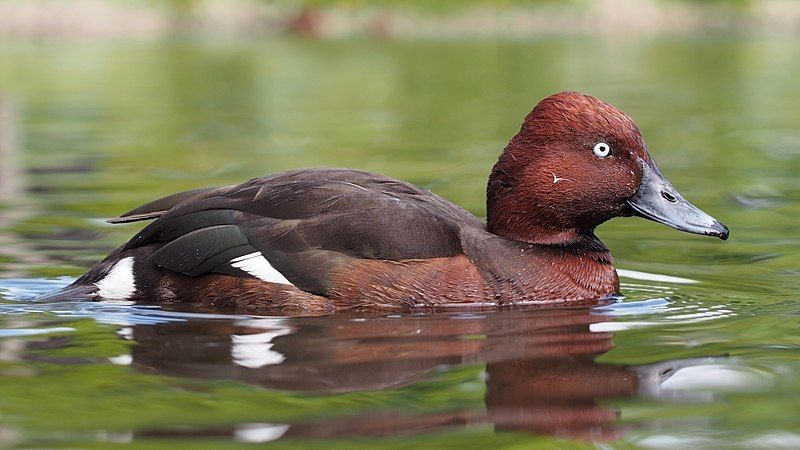
The ferruginous duck is an aquatic bird found in Eurosiberia and is also known by several other names, including ferruginous pochard, common white-eye, and white-eyed pochard.
It is a medium-sized diving duck species whose scientific name comes from the Greek aithuia and nyrok, the Russian word for a duck. Lithuania comes from ancient Greek authors, including Hesychius and Aristotle, and refers to an unidentified seabird.
It is believed to have been used to describe this particular duck species. The name nyrok is derived from the Russian language and is the traditional name used for the ferruginous duck. The ferruginous duck is a social species often seen in small flocks or pairs.
It has a distinctive reddish-brown plumage iridescent in sunlight and a white ring around its eyes. The bird is a strong swimmer and can dive deep underwater to find food. It mainly feeds on aquatic insects, mollusks, and crustaceans.
The ferruginous duck is a species of conservation concern due to its declining population. It is threatened by habitat loss, hunting, and climate change. Conservation efforts are being made to help protect this species and its habitat.
| Kingdom | Animalia |
| Phylum | Chordata |
| Class | Aves |
| Order | Anseriformes |
| Family | Anatidae |
| Genus | Aythya |
| Species | A. nyroca |
16. Red-crested Pochard
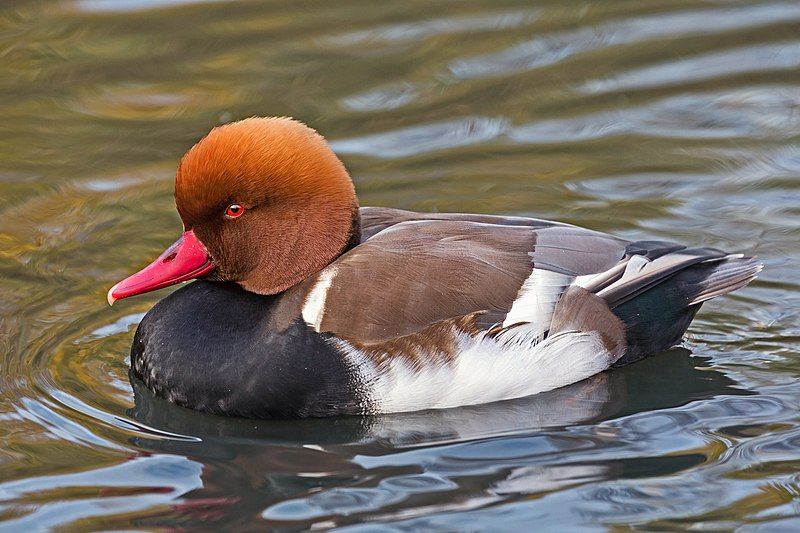
The red-crested pochard is a species of diving duck found in various habitats, from freshwater to brackish water. It is a large bird with a long, slender neck and a distinctive red crest on its head.
The scientific name of this species is derived from two ancient languages, Greek and Latin. The Greek word Netta refers to a duck, while the Latin word Rufina translates to “golden-red,” referring to the distinctive red crest of the red-crested pochard.
This duck is known for its ability to dive for food in deeper waters. As such, it is a valuable food source for many animals, including other birds, mammals, and fish.
The red-crested pochard is also essential to the natural environment as it helps maintain healthy aquatic ecosystems.
| Kingdom | Animalia |
| Phylum | Chordata |
| Class | Aves |
| Order | Anseriformes |
| Family | Anatidae |
| Genus | Netta |
| Species | N. rufina |
17. Black-winged Stilt
The black-winged stilt (Himantopus himantopus) is a species of wading bird in the avocet and stilt family, which inhabits wetlands and shallow bodies of water in many parts of the world.
It is a long-legged bird with long, thin, black-colored legs with a wingspan of up to 71 centimeters.
Its diet predominantly consists of aquatic insects, crustaceans, and other small animals. The black-winged stilt is a widely distributed species in Europe, Africa, Australia, the Middle East, and parts of Asia and the Americas. Its scientific name is H.
Himantopus is sometimes applied to a single, almost cosmopolitan species, meaning it can be found in various regions and habitats. The black-winged stilt has a black head and neck, a white underside, and a long, thin, black bill.
The back and wings are dark brown or black, and the legs are bright red. Males and females have similar plumage. The species is territorial and can be seen patrolling its preferred wetlands.
It builds its nest on the ground, usually near water, and lays three to four pale green eggs. The black-winged stilt is vulnerable to habitat loss and is listed as a species of most minor concern by the International Union for Conservation of Nature (IUCN).
It is an essential species in many wetlands, as its presence helps keep aquatic insect populations in check and provides food for other species.
| Kingdom | Animalia |
| Phylum | Chordata |
| Class | Aves |
| Order | Charadriiformes |
| Family | Recurvirostridae |
| Genus | Himantopus |
| Species | H. himantopus |
18. Bearded Vulture
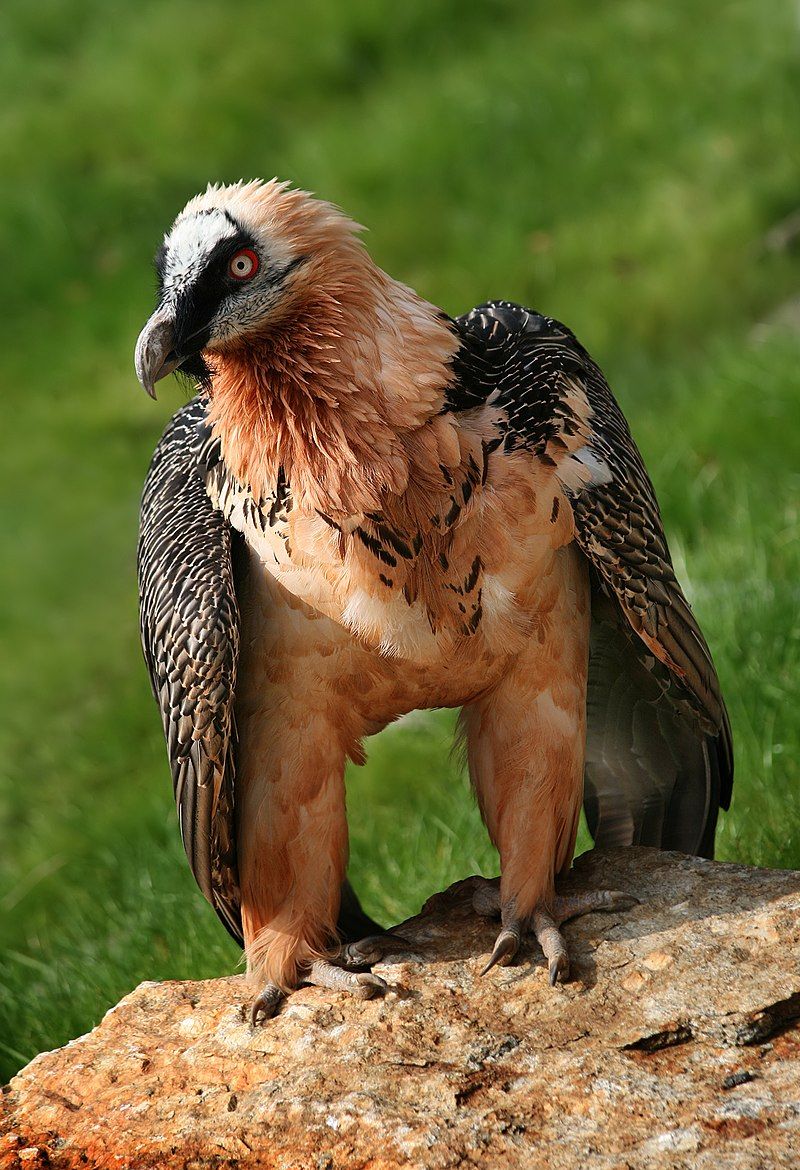
The Bearded Vulture is an impressive bird of prey found in mountainous regions in Europe, Asia, and Africa. It is the only member of the genus Gypaetus and belongs to the family Accipitridae, which includes eagles, hawks, and kites.
It is a massive bird with a wingspan of up to 2.3 meters and is easily recognizable by its black and white feathers.
Its scientific name, ‘lammergeier’ or ‘suffrage,’ translates to ‘bone-breaker,’ a reference to its habit of dropping large bones onto rocks to break them open and access the marrow inside.
Historically, the Bearded Vulture was classified as an Old World vulture. However, more recent research suggests it is more closely related to the Egyptian Vulture.
This would make it the only member of its subfamily, Gypaetinae, and further links it to the accipitrid family. The Bearded Vulture is an essential member of its ecosystem, as it plays a vital role in the scavenging of carcasses and helps to keep the environment clean.
It has a distinctive diet of bone marrow and is well known for its ability to drop bones from great heights to break them open. This behavior has earned it the nickname ‘bone-breaker’.
The Bearded Vulture is an endangered species listed on the International Union for Conservation of Nature’s Red List of Threatened Species.
| Kingdom | Animalia |
| Phylum | Chordata |
| Class | Aves |
| Order | Accipitriformes |
| Family | Accipitridae |
| Genus | Gypaetus |
| Species | G. barbatus |
19. Baikal Teal
The Baikal teal is a species of dabbling duck native to Eastern Russia. A few names, including the bimaculate and squawk ducks, know it.
This duck species is known for its migratory tendencies, breeding in Eastern Russia during the summer months and then traveling south in the autumn to East Asia for the winter months. The Baikal teal is a small duck species, usually 24-25 cm long, with a wingspan of around 40 cm.
The males have a distinctive coloring: a light brown head, a black line running through the eyes, and a brownish-black body with a white patch on the lower back.
The females are usually a bit duller in color, with darker wings and a brownish back. The Baikal teal is an omnivorous species, feeding mainly on small aquatic plants and insects. They often prefer to feed in shallow, freshwater marshes in large flocks.
Breeding usually occurs in early spring, with the males arriving at the breeding grounds first and engaging in aggressive territorial behavior to defend their nesting sites.
The females will arrive a few weeks later and lay a clutch of around 8 to 10 eggs. The Baikal teal is listed as a vulnerable species, mainly due to overhunting and changes in its habitats due to human activities.
Conservation efforts are in place to help protect this species, including creating protected areas and strict hunting regulations.
| Kingdom | Animalia |
| Phylum | Chordata |
| Class | Aves |
| Order | Anseriformes |
| Family | Anatidae |
| Genus | Sibirionetta |
| Species | S. formosa |
20. See-see Partridge
The See-See Partridge is a species of gamebird belonging to the Phasianidae family of the Galliformes order of birds. Galliformes are a diverse group of gallinaceous birds, including chickens, quails, grouse, and pheasants.
These birds are usually found in open woodland, grasslands, and scrubland. The See-See Partridge is native to a large area of the Middle East, stretching from southeastern Turkey through Syria and Iraq, east to Iran and Pakistan.
This species is found in various habitats, from arid steppes to mountain forests.
They prefer to live in open areas with plenty of shrubs and trees, where they can hide in the undergrowth and feed on insects, seeds, and berries. The See-See Partridge is a medium-sized gamebird, growing to around 26-30 cm in length.
They have mottled brown plumage, white neck and back spots, and a distinctive white-ringed eye. Their call is a sharp, loud “see-see” which can be heard from quite a distance. The See-See Partridge is a popular gamebird hunted for food and sport.
This species is also widespread in aviculture, bred for its attractive plumage and loud call.
| Kingdom | Animalia |
| Phylum | Chordata |
| Class | Aves |
| Order | Galliformes |
| Family | Phasianidae |
| Genus | Ammoperdix |
| Species | A. griseogularis |
21. Grebes
Grebes are a group of birds that belong to the order Podicipediformes, commonly found in freshwater habitats worldwide. They are aquatic birds, able to dive into the water for food.
During migration and winter, some species of grebes can also be found in marine habitats, providing them with a broader range of food sources. The majority of grebes can fly, although there are a few flightless species.
This is most commonly seen in stable lakes, where the grebes have adapted to their environment. These flightless birds can swim quickly underwater, providing them with protection from predators.
The adaptations of these birds to their environment are pretty remarkable and demonstrate the diversity of the grebes.
| Kingdom | Animalia |
| Phylum | Chordata |
| Class | Aves |
| Clade | Mirandornithes |
| Order | Podicipediformes |
| Family | Podicipedidae |
22. Pallid harrier
The pale or pallid harrier is a species of migratory bird of prey belonging to the harrier subfamily. Its scientific name, Circus macrourus, is derived from the Ancient Greek language. Kirkos is the Greek word for a bird of prey, most likely referring to the hen harrier.
Makros, meanwhile, means “long,” and -ours “-tailed,” which combined gives us the description “long-tailed” for the pale or pallid harrier. This refers to the bird’s distinctive long tail, which sets it apart from other members of the harrier subfamily.
The pale or pallid harrier is one of the most widely distributed and common harriers and is found in various habitats worldwide including wetland, grassland, and agricultural areas.
They are well-adapted for hunting, with their long wings allowing them to fly low over the ground and search for prey. They can also circle high in the air in search of prey, which is likely the source of their name.
| Kingdom | Animalia |
| Phylum | Chordata |
| Class | Aves |
| Order | Accipitriformes |
| Family | Accipitridae |
| Genus | Circus |
| Species | C. macrourus |
23. Montagu’s Harrier
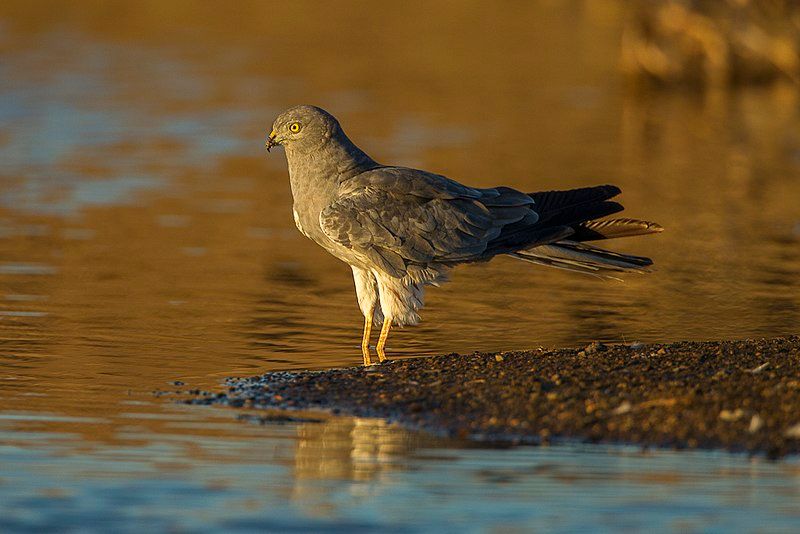
Montagu’s harrier is a species of bird belonging to the harrier family. The harrier family consists of various species of birds of prey, such as hawks and eagles, which typically hunt using their keen eyesight.
The Montagu’s harrier is a migratory species, meaning it travels to different locations in search of food or a suitable climate for breeding.
The species is named after the British naturalist George Montagu, who studied and documented various species of birds throughout his career. Montagu was an avid birdwatcher and was well-known for his contribution to studying British bird species.
He is credited with discovering several species of birds, including the Montagu’s harrier. The species is named after him to commemorate his contribution to the field of ornithology.
| Kingdom | Animalia |
| Phylum | Chordata |
| Class | Aves |
| Order | Accipitriformes |
| Family | Accipitridae |
| Genus | Circus |
| Species | C. pygargus |
24. White-rumped Vulture
The white-rumped vulture is an Old World native to South and Southeast Asia. It is a species particularly vulnerable to population decline due to environmental changes and human activities.
In 2000, the International Union for Conservation of Nature (IUCN) listed the white-rumped vulture as Critically Endangered. This means that their population has decreased dramatically and is now facing a significant risk of extinction.
The leading cause of this population decline is diclofenac poisoning. Diclofenac is a painkiller and anti-inflammatory drug used to treat livestock and is widely used in South and Southeast Asia.
When the vultures feed on the carcasses of animals that have been treated with diclofenac, the drug accumulates in their bodies and causes kidney failure, leading to death. This has had a devastating effect on the vulture population, leading to their current endangered status.
To protect and conserve the white-rumped vulture, it is essential to reduce the use of diclofenac in livestock. There are several other alternatives available that are non-toxic to vultures.
It is also essential to create protected areas for vultures to roost and breed in and monitor their population levels to ensure that they are not declining further.
| Kingdom | Animalia |
| Phylum | Chordata |
| Class | Aves |
| Order | Accipitriformes |
| Family | Accipitridae |
| Genus | Gyps |
| Species | G. bengalensis |
Conclusion
The birds of Kabul are a unique and essential part of the city’s ecology. They provide a vital food source for the local people and a connection to the natural world.
The city’s bird species diversity is remarkable, and the numbers have been increasing over time. This is a testament to the efforts of conservationists and residents who are committed to protecting and preserving the city’s avian population.
The birds of Kabul are an important part of the city’s ecosystem and deserve protection and appreciation.